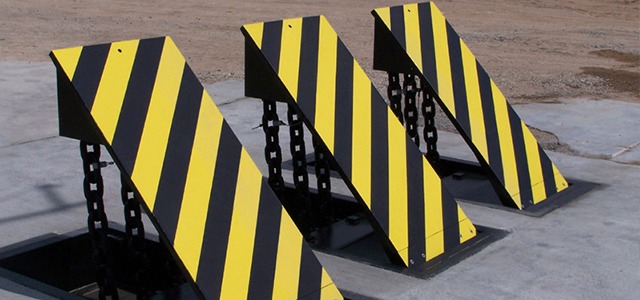Some Known Questions About Wedge Barriers.
Wiki Article
A Biased View of Wedge Barriers


The spring pole 58 is combined to a cam(e. g., camera 80 revealed in FIG. 4) of the training device 50. The springtimes 60 disposed about the spring pole 58 are held in compression by springtime sustains 62, consisting of a fixed springtime assistance 64. That is, the fixed springtime assistance why not check here 64 is taken care of family member to the structure 14 and the remainder of the bather 10.
8 Simple Techniques For Wedge Barriers
The remaining pressure used to the cam to deploy the wedge plate 16 may might provided by an electromechanical actuator 84 or other actuator. The springtime setting up 54 and the actuator 84(e. Wedge Barriers. g., electromechanical actuator)might operate together to equate the camera and raise the wedge plate 16.
As pointed out above, the spring setting up 54 exerts a consistent pressure on the web cam, while the electromechanical actuator might be managed to put in a variable pressure on the web cam, therefore making it possible for the lifting and reducing( i. e., releasing and retracting )of the wedge plate 16. In particular personifications, the continuous force applied by the spring setting up 54 might be flexible. g., electromechanical actuator) is impaired. As will certainly be appreciated, the springtime setting up 54 might be covered and protected from debris or other aspects by a cover plate(e. g., cover plate 68 received FIG. 4) that may be substantially flush with the elevated surface 38 of the foundation 14. As mentioned over, in the deployed setting, the wedge plate 16 offers to obstruct accessibility or travel past the barrier 10. For instance, the barrier 10(e. g., the wedge plate 16 )may block pedestrians or vehicles from accessing a building or path. As discussed over, the obstacle 10 is connected to the anchor 30 safeguarded within the structure 14,

front braces 71. As a result, the link settings up 72 might pivot and rotate to allow the collapse and extension of the affiliation assemblies 72 during retraction and deployment of the bather 10. The linkage assemblies 72 reason motion of the wedge plate 16 to be limited. For instance, if a lorry is traveling towards the released wedge plate 16(e. For instance, in one scenario, the safety and security legs 86 might be expanded throughoutupkeep of the obstacle 10. When the safety and security legs 86 are released, the safety and security legs 86 sustain the weight of the wedge plate 16 against the surface 12. Therefore, the training device 50 might be shut down, serviced, removed, replaced, etc. FIG. 5 is partial perspective sight of an embodiment of the surface-mounted wedge-style obstacle 10, highlighting the cam 80 and the cam surface areas 82 of the training device 50. Especially, 2 cam surfaces 82, which are described as reduced webcam surface areas 83, are positioned below the cam 80. The lower webcam surfaces 83 may be dealt with to the surface area 12 (e. For instance, the reduced web cam surface areas 83 and the mounting plate 85 might form a solitary piece that is protected to the anchor 30 by screws or various other mechanical fasteners. Additionally, 2 camera surface areas 82, which are described as upper cam surfaces 87, are placed above the camera 80 and paired to (e. In various other personifications, interfering layers or plates might be positioned between the surface area 12 and the lower webcam surfaces 83 and/or the wedge plate 16 and the top web cam published here surfaces 87 As discussed above, the cam 80 translates along the camera surface areas 82 when the wedge plate 16 is raised from the withdrawed position to the deployed setting. Additionally, as mentioned above, the springtime assembly 54 (see FIG. 3 )might offer a pressure acting on the cam 80 in the instructions 102 via springtime rod 58, which might minimize the force the electromechanical actuator 84 is needed to put on the web cam 80 in order to actuate and raise the wedge plate 16. 1 )to the deployed setting(see FIG. 4). As reference revealed, the web cam 80 includes track wheels 104(e. g., rollers), which get in touch with and translate along the camera surface areas 82 during procedure.
Report this wiki page